Poverty Alleviation: China's Experience and Contribution
The State Council Information Office of the People's Republic of China
April 2021
First Edition 2021
ISBN 978-7-119-12645-6
© Foreign Languages Press Co. Ltd., Beijing, China, 2021
Published by Foreign Languages Press Co. Ltd.
24 Baiwanzhuang Road, Beijing 100037, China
Distributed by China International Book Trading Corporation
35 Chegongzhuang Xilu, Beijing 100044, China
P.O. Box 399, Beijing, China
Printed in the People's Republic of China
Contents
Preface
I. The Solemn Commitment of the CPC
II. Final Victory in the Fight Against Extreme Poverty
III. The Strategy of Targeted Poverty Alleviation
IV. Exploring a New Path of Poverty Alleviation
V. A Global Community of Shared Future Free from Poverty
Conclusion
Appendix
Preface
Poverty is a chronic affliction of human society and a common challenge faced by the whole world. Poverty and its associated problems, including hunger, diseases, and social conflicts, are serious impediments to people's pursuit of a better life, so the eradication of poverty has always been a wish to be fulfilled. The history of humankind is the history of relentless struggle against poverty.
China is the world's largest developing country, with a population of 1.4 billion. In addition to its weak foundations and uneven development, the nation had long been plagued by poverty at a scale and a level of severity that has rarely been seen anywhere else in the world. As a result, the challenge of poverty alleviation in China almost defies imagination.
This year marks the 100th anniversary of the founding of the Communist Party of China (CPC). Over the past century, the Party has united and led the Chinese people in the battle against poverty with unwavering faith and will. Since the 18th CPC National Congress in 2012, the Party Central Committee, with General Secretary Xi Jinping at the core, has fought a decisive battle against poverty that is unprecedented in scale and intensity, and has benefited the largest number of people in human history. At a grand gathering held on February 25, 2021, to mark China's achievements in poverty alleviation and to honor its model fighters against poverty, General Secretary Xi solemnly declared: Victory in the battle against poverty is complete, and China completed the arduous task of eliminating extreme poverty.
China is home to nearly one fifth of the world's population. Its complete eradication of extreme poverty – the first target of the UN 2030 Agenda for Sustainable Development – 10 years ahead of schedule, is a milestone in the history of the Chinese nation and the history of humankind, making an important contribution to the cause of global poverty alleviation.
Poverty is not predestined, nor is it unconquerable. China's experience in poverty alleviation indicates that courage, vision, sense of responsibility, and the eagerness to take on challenges are the most essential. With strong will and determination, as well as practical action, one can make steady progress towards overcoming poverty and realizing common prosperity.
This white paper is being issued to record the course of the Chinese people's great fight in eliminating extreme poverty, introduce China's approach, and share its experience and actions in poverty alleviation.
I. The Solemn Commitment of the CPC
The Chinese nation has a long history, diligent and intelligent people and splendid civilization. Over the history of thousands of years, eliminating poverty has been the persistent goal of the Chinese people, who suffered hardships and difficulties frequently. From the middle of the 19th century, foreign aggression and the decadence of the imperial dynasty reduced China to a semi-colonial, semi-feudal society, and hundreds of millions of its people were plunged into poverty or even extreme poverty. But the Chinese people have fought with fortitude to realize their dream – achieving economic prosperity, national rejuvenation, and a happy and better life.
1. The CPC Led the People to Win Victory in the Revolution, Build the People's Republic of China (PRC), Opening a New Journey Towards Prosperity
The founding of the CPC in July 1921 was an epochal event in China's history. The CPC has taken the happiness of the people and rejuvenation of the nation as its aspiration since its founding, and united and led the people to fight for a better life over the decades. The Party's first generation of central collective leadership under Mao Zedong regarded the liberation of peasants as the fundamental issue of the revolution, led the people to launch the Agrarian Revolution to realize the goal of "the land to the tiller", overthrew the rule of imperialism, feudalism, and bureaucrat-capitalism, and won victory in the New Democratic Revolution and established the PRC, bringing an end to sustained oppression, exploitation of the people, frequent wars, and partitioning of the country, and realizing the goals of national independence and people's liberation. This helped to remove the obstacles to China's progress, and created the political conditions it needed to eradicate poverty, regain national strength, and realize prosperity for everyone.
The founding of the PRC on October 1, 1949, allowed the Chinese people to stand upright and become the true masters of the country. To change the backward situation starting from scratch, the CPC united and led the people to rely on themselves and strived to build their homeland with strong determination and concerted effort. Land reform was rolled out across the country, abolishing the feudal land system that had endured for over 2,000 years. This removed the major institutional obstacle to eliminating poverty. Socialist transformation was carried out in agriculture, individual craft industries, and capitalist industry and commerce. The establishment of the socialist system provided a basic institutional guarantee for addressing the root causes of poverty. Socialist development was carried out on all fronts, creating an independent and rather complete industrial system and economic system. Efforts were made to develop the collective economy, improve farmland irrigation and water conservation, and develop rural education and cooperative medical services. A preliminary social security system took shape, with the collective economy at the base, and the "five guarantees"[ The National Agricultural Development Program (1956-1967) specified that agricultural cooperatives should give proper care to commune members who could not work and had no family to support them, by providing them with proper food, clothing, fuel, and education (for children and teenagers), and by paying their burial expenses. ] and relief for people in extreme poverty as the core. The Chinese people – including the farmers – who made up nearly one quarter of the world's population, saw their basic living needs met. Their living standards and educational level improved. Socialist building during this period pressed ahead amidst successes and setbacks.
2. Reform and Opening Up Accelerated Development and Poverty Alleviation in China
Held in December 1978, the Third Plenary Session of the 11th CPC Central Committee ushered in a new chapter of reform and opening up and socialist modernization in China. Reform and opening up has been another great revolution in the history of the Chinese people and Chinese nation, injecting momentum and innovation. The rapid socioeconomic development that ensued gave a vigorous boost to poverty alleviation, and resulted in a sharp decline in the impoverished population.
In the initial period of reform and opening up, confronted by the grim challenge of a large rural impoverished population base and a high incidence of poverty, the second generation of the central collective leadership headed by Deng Xiaoping issued a declaration that "Poverty is not socialism; socialism means eliminating poverty". It set the goal of ensuring the people a moderately prosperous life by the end of the 20th century, formulated a three-step strategic plan[ The 13th CPC National Congress proposed that a three-step strategic plan for China's economic development would be laid out after the Third Plenary Session of the 11th CPC Central Committee: doubling the 1980 GNP by the end of the 1980s and ensuring that the people would have adequate food and clothing as the first step; doubling the 1990 GNP by the end of the 20th century and ensuring the people a moderately prosperous life as the second step; and increasing the per capita GNP level to that of moderately developed countries, ensuring the people a relatively affluent life, and realizing basic modernization by the middle of the 21st century as the third step. ], and articulated the vision of "Two Development Strategies"[ In 1988, Deng Xiaoping proposed that "The coastal areas, which comprise a vast region with a population of 200 million, should accelerate their opening to the outside world, and we should help them develop rapidly first; afterwards they can promote the development of the interior. The development of the coastal areas is of overriding importance, and the interior provinces should subordinate themselves to it. When the coastal areas have developed to a certain extent, they will be required to give more help to the interior. Then, the development of the interior provinces will be of overriding importance, and the coastal areas will in turn have to subordinate themselves to it." (Source: "The Central Leadership Must Have Authority", Selected Works of Deng Xiaoping, Vol III.) ]. A swathe of major reforms involving agriculture and rural areas were launched, providing for a massive, planned, well-organized poverty alleviation effort at the national level. The two-tier management system adopted in the rural areas, integrating cooperative management with household contract management, clarified the most basic production relations and inspired the farmers' enthusiasm, bringing an end to a period of protracted stagnation in agricultural output. Reform of the distribution system for agricultural products was enacted. A major effort was made to develop township enterprises in order to increase overall incomes in rural areas. Special poverty alleviation agencies were set up, poverty standards were set, key impoverished areas and counties were identified, and a special plan for agricultural development in the three western regions[ The three western regions were Hexi Region and Dingxi Region in Gansu Province and the mountainous region in southern Ningxia Hui Autonomous Region, the most impoverished contiguous areas in the country at the beginning of reform and opening up. In December 1982, China launched poverty alleviation initiatives in these regions to boost their agricultural development. This involved 47 counties, cities and districts (which expanded to 57 in 1992). It was a groundbreaking project in China's poverty alleviation efforts. It set a precedent in regional poverty alleviation, accumulating rich experience in moving from relief-based poverty alleviation to development-driven poverty alleviation, pooling resources for the development of impoverished areas, for poverty alleviation through relocation, and for combining development-driven poverty alleviation with developing the eco-economy. These successful measures have had a profound influence on massive, planned, well-organized poverty alleviation efforts across the country starting from 1986. ] was launched. These measures liberated the rural productive forces, released vitality, boosted economic development, increased farmers' incomes, and updated their mindsets. Development-driven poverty alleviation opened a new chapter in China.
By the early 1990s, there had been visible progress in poverty alleviation in rural areas. In the meantime, poverty had evolved from a widespread problem into one afflicting particular regions, groups and populations, highlighting the problem of uneven regional development. The Party's third generation of central collective leadership with Comrade Jiang Zemin at the core formulated a three-step development strategic plan[ The 15th CPC National Congress held in 1997 drew up a new three-step strategic plan. The first step involved doubling the 2000 GNP, giving the people greater prosperity, and putting in place a relatively complete socialist market economy system, all by the end of 2010. The second step involved working hard for another decade to further develop the economy by the centenary of the CPC, and to improve all relevant systems. The third step involved realizing basic modernization and developing China into a modern socialist country that is prosperous, strong, democratic, and culturally advanced by the time we celebrate the centenary of the PRC in the middle of the 21st century. ], put forward the goal of achieving moderate prosperity in all respects, and continued to press ahead with massive national campaigns on poverty alleviation. In 1994, the State Council launched the Priority Poverty Alleviation Program (1994-2000), China's first ever national poverty alleviation program with definite goals, targets, measures and deadlines. It committed to ensuring that the basic needs of 80 million impoverished rural residents would be met in the seven years from 1994 to 2000. In 1996, the central authorities held the National Conference on Development-driven Poverty Alleviation, further clarifying the steadfast commitment to the goal of being able to provide adequate food and clothing for the impoverished people by the end of the 20th century and confirming the shift from relief-based poverty alleviation to development-driven poverty alleviation. In 1999, the central authorities held the National Conference on Development-driven Poverty Alleviation, making plans to ensure success of the Priority Poverty Alleviation Program. Another conference on poverty alleviation was convened in 2001, and the State Council issued the Outline of Development-driven Poverty Alleviation in Rural Areas (2001-2010). On the basis of initial progress of China's poverty alleviation, the campaign continued with further measures. By the end of 2000, the impoverished population in rural areas had been reduced to 32.09 million and the incidence of poverty down to 3.5%, based on the poverty alleviation standard at the time.
In the 21st century, the CPC Central Committee with Comrade Hu Jintao as General Secretary embraced the Scientific Outlook on Development. Its goals were to advance the development of a harmonious society, build a moderately prosperous society in all respects, and facilitate the development of a new socialist countryside.
It enacted a new series of poverty alleviation policies and measures. This resulted in major adjustments to the focus and targets of poverty alleviation work, listing the central and western regions as the priority region, and choosing as individual targets 150,000 impoverished villages besides the 592 key counties, where the full participation of villagers in poverty alleviation efforts was encouraged.
A whole range of efforts were directed to business development, the training and transfer of rural labor, poverty alleviation through relocation, and relocation for the development of the eco-economy. State strategy of regional development was implemented, such as developing west China, revitalizing old industrial bases in the northeast, and stimulating the rise of the central region. These achieved coordinated development between regions and between rural and urban areas. The Agricultural Tax was abolished and a series of rural social security systems such as the new cooperative medical care system were established, greatly easing the burden on farmers. The National Conference on Development-driven Poverty Alleviation in 2011 made plans for a new phase in the battle against poverty to ensure that moderate prosperity in all respects would be achieved by 2020. After the meeting, the CPC Central Committee and the State Council issued the Outline of Development-driven Poverty Alleviation in Rural Areas (2011-2020). China's poverty alleviation effort had evolved from its primary mission – meeting the basic needs of the poor – to a new stage of consolidating this achievement, accelerating poverty alleviation, improving the eco-environment, increasing development capacity, and bridging the development gap. By the end of 2010, according to the poverty standard, the impoverished rural population had been reduced to 26.88 million, and the incidence of poverty had fallen to 2.8%. In 2011, the standard was raised to RMB2,300, and accordingly the poor population was 122 million.
3. China in a New Era and a New Battle Against Poverty
China marched into a new era after the 18th CPC National Congress in 2012. The country reached a critical stage in building a moderately prosperous society in all respects and achieving the First Centenary Goal. Rapid economic and social development, a marked increase in comprehensive national strength, a better social security system, and progress in modernizing China's system and capacity for governance provided solid manpower, material, and financial foundations and strong institutional support for its poverty alleviation efforts. But the country still faced a daunting challenge since it had to solve the most difficult problems in raising the poorest population out of poverty in the coming period. China's battle against extreme poverty had entered the toughest stage. It was hard to complete the task with conventional approaches and ideas. To achieve the goal of poverty alleviation, the nation had to pull together with greater determination, sharper thinking, more targeted measures, and extraordinary efforts.
The CPC Central Committee with Comrade Xi Jinping at the core takes the desire of the people for a better life as its goal. It has committed to realizing the Chinese Dream of national rejuvenation and securing a decisive victory in building a moderately prosperous society in all respects. Poverty alleviation, a key task and index of the realization of the First Centenary Goal, has been included in the Five-sphere Integrated Plan and the Four-pronged Comprehensive Strategy. The CPC set the goals that by 2020 it would help all the rural population out of poverty as defined by the existing standard, raise all impoverished counties out of poverty, and eliminate poverty over entire regions – mobilizing the whole Party, the whole country, and all sectors of society to engage in this battle. President Xi Jinping, always concerned about impoverished regions and families in straitened circumstances, has always put poverty alleviation at the top of his work agenda and devoted much of his energy to it. He has presented a series of important ideas and proposals, and made some major policy decisions. The 18th CPC National Congress in 2012 set the goal of building a moderately prosperous society in all respects. Soon after that, Xi enunciated, "To achieve initial prosperity in the countryside, it is essential to raise rural living standards and particularly those of impoverished villagers." Launching the campaign against poverty in the new era, he also emphasized, "No single poor area or single poor person should be left behind in achieving this goal." In 2013, on his inspection tour to Shibadong Village, Huayuan County, Hunan Province, Xi proposed for the first time the concept of "giving differentiated guidance for targeted poverty alleviation in line with local conditions by seeking truth from facts". In 2014, while attending the deliberation session of the Guizhou delegation at the Second Plenary Session of the 12th National People's Congress, Xi stated, "Inspection tours must be conducted to identify the truly poor. Poverty alleviation must reach those who truly need it, and poverty must be fully eliminated." In 2015, at the National Conference on Development-driven Poverty Alleviation, he sounded the bugle call to battle, "We should be determined, dedicate ourselves, and work hard towards the goal." In 2017, in the report to the 19th CPC National Congress, Xi emphasized the need to mobilize the energies of the whole Party, the whole country, and the whole of society to win the battle against extreme poverty and eradicate it, "Ensuring that poor people and poor areas will enter the moderately prosperous society together with the rest of the country is a solemn promise made by our Party… We must win the battle against poverty." In 2020, faced with the sudden attack of Covid-19, Xi mapped out new plans for mobilization at a seminar on poverty alleviation, emphasizing that lifting poor people in the rural areas out of poverty "must be achieved as scheduled". "It is non-negotiable. This is a tough battle with no route of retreat. We must double our efforts till the last minute. We must not pause, slacken off or be negligent." He asked the whole Party to perform well in this "difficult test", to apply more determination and more vigor, and to be confident of bringing the battle to a successful end.
President Xi Jinping has assumed leadership, made plans, and directed the battle in person.
He has attended the National Conference on Development-driven Poverty Alleviation, and presided over seven seminars on poverty elimination. He has made over 50 fact-finding trips. In every one of the last five years, he has reviewed the evaluation reports of the poverty alleviation work. In every one of the last seven years, he has attended important events or issued directives on the National Poverty Alleviation Day. In every one of the last seven years, he has expounded on the fight against extreme poverty in his New Year address. In every one of the last eight years, he has discussed plans for the battle against poverty with delegates during the Two Sessions and written letters to encourage grassroots officials and communities to engage in the great fight. He has visited every one of the 14 contiguous poor areas across the country and over 20 poor villages, and sat in the homes of impoverished households to hear of their difficulties, suggestions, and needs, building up their confidence and determination, and their belief that they can work their way out of poverty. On February 25, 2021, at the National Poverty Alleviation Summary and Commendation Conference, he declared that China had secured a comprehensive victory in the fight against poverty, and completed the arduous task of eradicating extreme poverty – an outstanding and historic achievement.
The strenuous process whereby the CPC has led the Chinese people in the battle against poverty has been extraordinary and difficult. Over the past 100 years, the Party has committed itself to the original aspiration of seeking happiness for the people, taken on its responsibility for the people, honored its promise to the people, and made huge sacrifices in fighting to win national independence and people's liberation, to make China prosperous and strong, and to bring common prosperity to all. In the process it has won the support and trust of the people.
Over the past 100 years the Chinese people, under the leadership of the CPC, have never faltered in pursuit of progress, have put in unimaginable efforts, and have relied on themselves to eradicate extreme poverty, and march towards shared all-round prosperity.
Over the past 100 years, under the leadership of the CPC, China has stood tall, become prosperous, and grown in overall national strength. The protection of the rights to subsistence and development, and the promotion of equality and justice have laid solid foundations for well-rounded human development.
II. Final Victory in the Fight Against Extreme Poverty
China's fight against poverty entered a critical stage after the 18th CPC National Congress in 2012. At the end of 2020, through eight years of hard work, China achieved the goal of eliminating extreme poverty – a key goal for the new era of building socialism with Chinese characteristics. The 98.99 million people in rural areas who were living below the current poverty threshold all shook off poverty (Figure 1); all the 128,000 impoverished villages and 832 designated poor counties got rid of poverty (Figure 2). China has eliminated poverty over entire regions and eradicated extreme poverty.
The battle against poverty has been another great revolution in rural China, leading to historic and comprehensive changes. The campaign saw an end to the backwardness of poverty-stricken areas, boosted overall rural development, resolved the greatest threat to success in achieving moderate prosperity in all respects, and laid a solid foundation for building a modern socialist China and realizing the Second Centenary Goal. China has secured a complete victory in the battle against extreme poverty, eliminating overall and extreme poverty for the first time in its history of thousands of years, and realizing a century-long aspiration of the Chinese people.
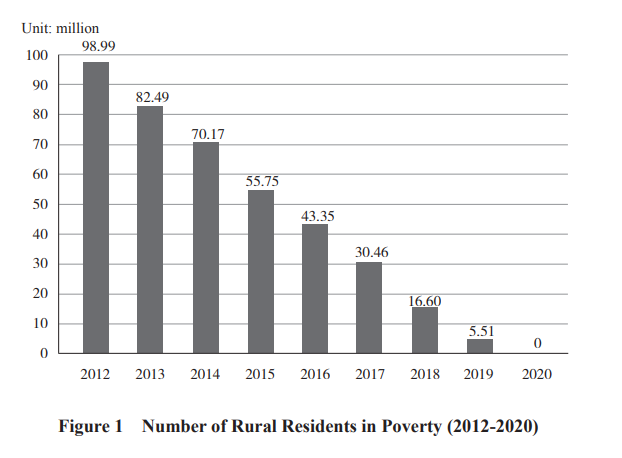
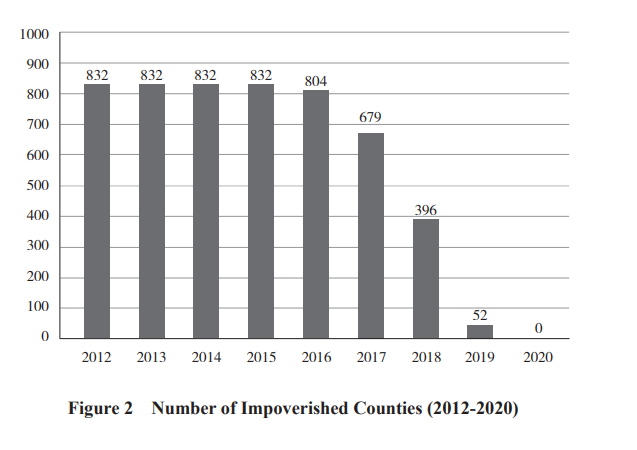
1. Significant Improvement in the Living Standards of the Poor
Through poverty alleviation, there has been a substantial improvement in the incomes and welfare of the poor. The Two Assurances and Three Guarantees[ This refers to assurances of adequate food and clothing, and guarantees of access to compulsory education, basic medical services and safe housing for impoverished rural residents. ] have been realized; education, healthcare, housing and drinking water supplies are much improved. These provisions have covered all basic needs and laid the foundations for future development. The fight against poverty has led to dramatic changes in the lives of the impoverished.
The incomes of the impoverished are increasing (Figure 3). The per capita disposable income of the rural poor increased from RMB6,079 in 2013 to RMB12,588 in 2020, up by 11.6% per annum on average. The growth rate was 2.3 percentage points higher than the national rural average. Their salary income and operative income kept increasing over the years in proportion to their transfer income, showing a stronger ability to shake off poverty through their own efforts.
Ethnic minority areas have made notable progress in fighting poverty. From 2016 to 2020, in the five autonomous regions (Inner Mongolia, Guangxi, Tibet, Ningxia and Xinjiang) and three provinces with a large multi-ethnic population (Guizhou, Yunnan and Qinghai), the number of the poor dropped by 15.6 million. Extreme poverty was eliminated in all 28 of the minority ethnic groups with a small population. Some ethnic groups, still at the later stage of primitive society when the PRC was founded in 1949, leapfrogged to socialism and then again made great strides towards moderate prosperity in all respects.
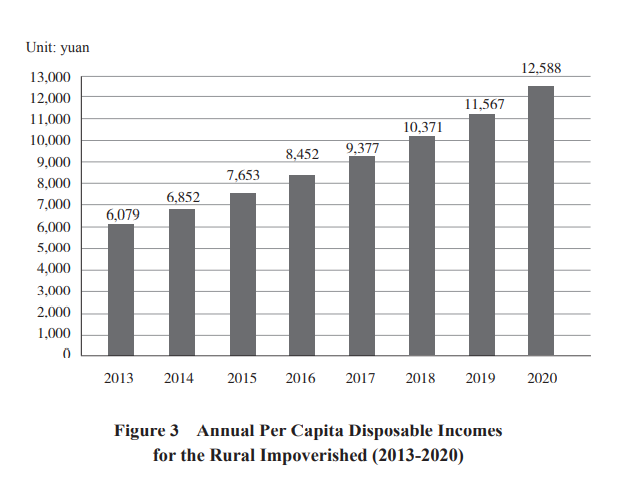
The Two Assurances and Three Guarantees have been realized. According to the national survey of poverty alleviation[ The national survey of poverty alleviation is a full review of China's progress in fighting poverty and has a fundamental importance for targeted poverty alleviation. From 2020 to 2021, the survey was conducted in 22 provinces and equivalent administrative units in central and western China, focusing on the veracity of poverty alleviation results, particularly the overall progress in designated poor counties. The survey includes registration of poverty-stricken populations, progress in the Two Assurances and Three Guarantees, participation of the impoverished in poverty alleviation programs, and basic public services in poor counties and villages. ], poor households now have adequate food and clothing all year round and a proper supply of nutritious food. They have clothing for all four seasons and comforters that protect them from cold weather.
Access to good quality education for the impoverished has improved remarkably; there are no dropouts in the countryside due to financial difficulties; nine-year compulsory education is now available to all children from rural poor households, and the completion rate in 2020 was 94.8%.
The three-tier healthcare system at village, township and county levels has been improved. All poverty-stricken populations now have access to basic medical insurance, critical illness insurance, and medical assistance, to ensure medical treatment to the impoverished with major illnesses, contracted healthcare to the impoverished with chronic diseases, and guaranteed medical services for the impoverished with critical illnesses. Basic medical insurance coverage of the poor is now over 99.9%. All the impoverished have been guaranteed medical services and medical insurance. Through these measures, China has resolved the problem of difficult and expensive access to medical treatment for poverty-stricken residents.
The program of renovation of dilapidated rural homes has ensured safe housing for all the impoverished (Box 1). The program of safe drinking water for rural residents has secured supplies to 28.89 million poor in terms of both quantity and quality, and benefited 382 million rural population; tap water coverage increased from 70% in 2015 to 83% in 2020.
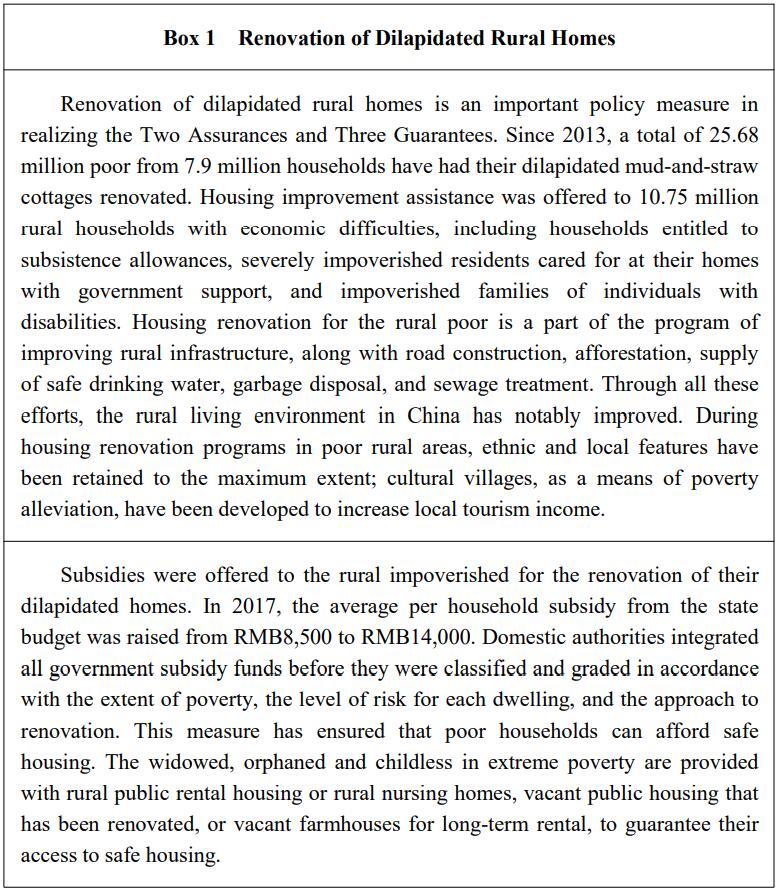
2. Poverty-stricken Areas Rid of Backwardness
Poor areas have long suffered from weak infrastructure, inadequate public services, and social and economic underdevelopment. In the final stages of fighting poverty, China succeeded in raising all the rural poor out of extreme poverty and the impoverished areas achieved a big stride in economic and social development, taking on a brand new look.
Infrastructure has been improved. Lack of access to transport, electricity, drinking water and communications hinders the development of poverty-stricken areas. Infrastructure construction is a basic element in the battle against poverty; through an intensified effort and further investment, new infrastructure in poor areas boosted their social and economic development.
The construction, management, maintenance and operation of roads in rural areas have all seen significant improvement (Box 2). Transport networks now connect all villages with other local villages and with the outside world, and provide them with safe and easy access to bus services. By the end of 2020, impoverished areas had gained 1.1 million km of reconstructed highways and 35,000 km of new railways; all the villages, townships and towns in poverty-stricken areas with the right conditions were accessible by paved road and provided with bus and mail routes, which facilitated more economic development.
Water infrastructure in impoverished areas has been improved in many ways. Since 2016, the effective irrigated area has increased by more than 5.35 million ha and water supply capacity has increased by 18.1 billion cu m. Better water infrastructure is also a provider of strong support for the development of poverty-stricken areas.
Electricity access in poor areas has been improved through power grid construction projects such as power supply to areas without electricity, upgrading of rural power grids, and construction of trunk power grids and power transmission channels. Now, more remote areas are connected to power grids, and almost all rural areas enjoy a steady power supply (Box 3).
Communications infrastructure has been extended in poverty-stricken areas. Now, over 98% of poor villages have access to optical fiber communications (OFC) and 4G technology; distance education is available at more schools in impoverished areas; telemedicine and e-commerce cover all designated poor counties. All of this represents an unprecedented pace of development of IT application in poverty-stricken areas.
This comprehensive range of infrastructure improvements has resolved many historical problems trapping poor areas in poverty, facilitated the flows of personnel, logistics, knowledge and information between poor areas and the outside world, and provided solid support for social and economic development in impoverished areas.

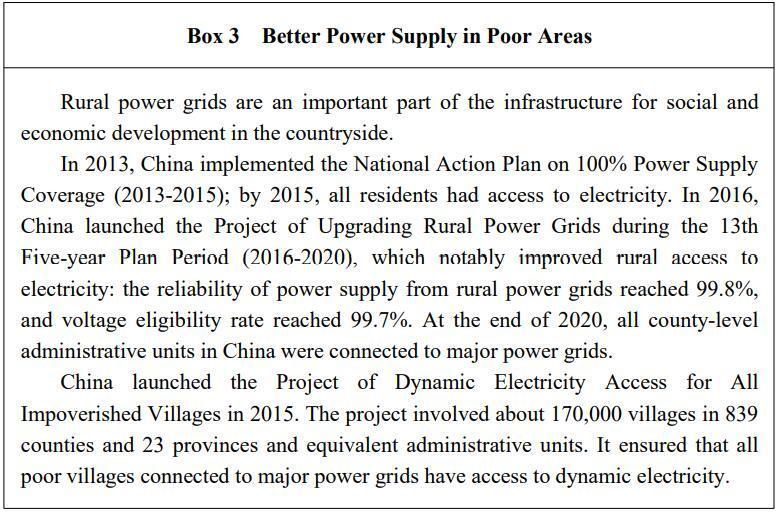
Basic public services have been improved. In addition to providing adequate food, clothing and safe housing for the impoverished, China has intensified efforts to improve basic public services covering education, healthcare, culture and social security. The goal is to guarantee impoverished people access to education, medical services, elderly care and social assistance, so as to support development in poverty-stricken areas.
Since 2013, China has renovated 108,000 schools to strengthen the provision of compulsory education in poor areas, and ensured that all school-age rural children receive kindergarten and elementary education within their own villages.
Public cultural services in poor areas have also been improved. By the end of 2020, 99.48% of villages in 22 provinces and equivalent administrative units in central and western China had seen their own cultural centers completed. The campaign of bringing culture to the countryside has enriched the cultural life of the rural poor.
There has been a notable improvement in healthcare provision in poor areas. This program has remedied the shortfall in medical workers and institutions at village and township level. 98% of the designated poor counties now have at least one grade-two hospital. The county-level hospitals in impoverished areas can treat 90% of the diseases that general county-level hospitals can. The impoverished can now have common ailments and chronic diseases treated at nearby medical institutions in a timely manner, and more major illnesses can be effectively treated at county-level hospitals.
Comprehensive social security systems are now in place in poor areas. The standards of eligibility for rural subsistence allowances in designated poor counties are all higher than the national poverty threshold.
Some 19.36 million impoverished people have been covered by rural subsistence allowances or extreme poverty relief funds, and 60.98 million by basic pension schemes for rural and non-working urban residents, achieving nearly 100% coverage.
The economy has achieved sustained and rapid growth. The battle against poverty has released the potential of poor areas, and injected vigor into their economic development.
Poverty-stricken areas have seen notable improvements in their economic structure. Businesses that leverage local strengths have been growing and thriving, including such new forms as e-commerce, photovoltaic technology, and tourism. The economy in poor areas has diversified, and effective market supply has increased. These developments provide solid foundations for economic growth.
The GDP of impoverished areas has maintained rapid growth. Since 2015, the average annual increment in per capita revenue from the national general public budget has been seven percentage points higher than the national average. A steady increase in incomes has created higher demand for life quality and cultural activities. This has stimulated a surge in consumption in rural areas, and provided support for the domestic economy.
Cultural heritage has been protected. China has strengthened the protection and promotion of traditional culture, folk culture and ethnic culture in poor areas to maintain a wealth of cultural diversity. It has implemented the Plan on the Revitalization of Traditional Chinese Craftsmanship to protect and develop fine craftsmanship in old revolutionary base areas, areas with large ethnic minority populations, border areas, and poverty-stricken areas. It has supported poor areas to develop cultural resources with local characteristics, including ethnic culture, revolutionary sites, folk culture, and intangible cultural heritage. Local governments in poor areas have developed tourism there by conserving and promoting these cultural resources and training support staff. China has paid attention to keeping a record of the experiences of ordinary people in poverty alleviation, such as archives of poor villages, films, TV programs and literary works themed on poverty alleviation. Through the protection and promotion of cultural heritage in poor areas, the impoverished have gained additional income while retaining their cultural roots.
The eco-environment has improved. China has integrated development-driven poverty alleviation with soil and water conservation and eco-environmental conservation. By developing the eco-economy, improving the rural living environment, and relocating the impoverished from inhospitable areas to places with better economic prospects, there have been remarkable improvements in the eco-environment of poverty-stricken areas. Lucid waters and lush mountains have become their invaluable assets. Through the fight against poverty, China has increased the incomes of the impoverished, improved the eco-environment of poor areas, and made the vast rural areas more livable spaces for their inhabitants.
Severely impoverished areas are the top priority in China's battle against poverty. The "three areas and three prefectures"[ The "three areas" refer to the Tibet Autonomous Region, the Hotan, Aksu, Kashgar prefectures and the Kizilsu Kirgiz Autonomous Prefecture in southern Xinjiang, and prefectures and counties with large Tibetan populations in the provinces of Sichuan, Yunnan, Gansu and Qinghai. The "three prefectures" refer to the Liangshan Yi Autonomous Prefecture in Sichuan Province, the Nujiang Lisu Autonomous Prefecture in Yunnan Province, and the Linxia Hui Autonomous Prefecture in Gansu Province. ] in extreme poverty have seen notable improvements in infrastructure, public services, and civil communal behavior, as well as rapid development in industries and businesses that leverage local strengths. All of these efforts have brought an end to regional and overall poverty (Box 4).
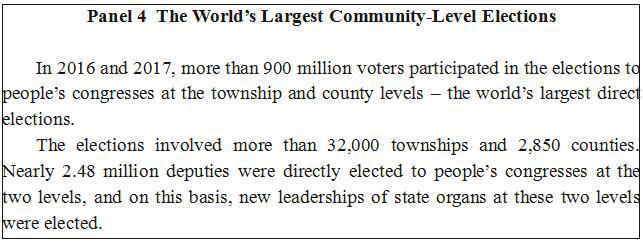
3. Those Who Have Been Lifted Out of Poverty Adopt a New Mindset
The battle against poverty is a profound revolution and complete victory on both material and theoretical level. Through this battle, the mindset of the poor has been enriched and sublimed – they have greater confidence, more active minds, and higher aspirations; they have experienced a thorough transformation from the inside to the outside.
The impoverished have a deep desire to rid themselves of the shackles of poverty and achieve prosperity. The poverty relief efforts have not only widened channels for the impoverished to improve their material welfare but rekindled their desire to seek a better life as well. Impoverished people have been inspired to seek prosperity through hard work, self-reliance, frugality and entrepreneurship, and strive for excellence. They are highly motivated and have more confidence about getting rid of poverty. As the Chinese people always say, "Good days come after hard work". They are ready to compete in the race to prosperity.
The impoverished have a stronger sense of self-reliance. The poverty alleviation work has set up a new platform for the impoverished to participate in collective affairs. When making major decisions on the implementation of poverty relief projects and the use of funds at the village level, villagers have carried out a "4+2" system[ "4+2" system refers to the democratic policy-making process on village affairs under the leadership of village Party organizations. "4" means four steps: Proposals should be put forward by the Party branch, jointly discussed by the village committee and the Party branch, and deliberated by Party members, and resolutions should be adopted by villagers' representatives; "2" means transparency on two levels – resolutions and implementation results should be made known to the public. ]. The oversight mechanisms for village affairs and villagers' councils and poverty relief councils have been improved to ensure that public affairs are discussed and handled by everyone. Under these arrangements, the impoverished have participated more in the decision making and implementation process in the battle against poverty. They have been more motivated to participate actively in collective affairs, more enthusiastic to build up their hometown, and more cohesive to develop the countryside.
The impoverished have been constantly upgrading their mindsets. The battle against poverty has opened the door to the outside world for poverty-stricken areas. Improvements in transport infrastructure have established links between poor areas and the outside world; development of public cultural undertakings has enriched the cultural life of impoverished people; with better access to the internet, the poor have greater knowledge, broader horizons, and a deeper understanding of openness, innovation, technology, rules and markets. They are capable of generating more ideas and opening wider channels for poverty alleviation.
Cultural and ethical work has been advancing in impoverished regions. Civility villages and towns are being built in poverty-stricken areas, and civil families cultivated under the "Five Family Virtues" program (encouraging respect for the law, diligent study, family planning, domestic harmony, and industrious and thrifty management of the household). Social etiquette, village rules, agreements among villagers, and councils on moral issues, weddings and funerals have been promoted, to update outmoded and undesirable habits and customs. Activities, such as competition for best households and families, have been organized to carry forward cherished family traditions, spread core socialist values, and enhance social etiquette and civility. Scientific, healthy and civilized new ways of life which are simple, green, eco-friendly, and hygienic have been embraced by the villagers. Good social practices, including modest weddings and funerals, filial piety, harmonious neighborhoods, and helping the needy, the weak and the disabled, have been promoted. In the new era, new cultural practices with a local and modern essence are developing in rural areas.
4. Protecting the Rights of Special Groups to Basic Needs and Development
China prioritizes the basic rights of subsistence and development of the disadvantaged groups among women, children, the elderly, and the disabled. The nation has enacted favorable policies and provided more assistance to raise the welfare level of these groups.
Living conditions of impoverished women have been improving. China adheres to the fundamental national policy of gender equality, and sees women as a key target in poverty alleviation. Among nearly 100 million who have shaken off poverty, women account for half. By implementing the Outline of Women's Development in China (2011-2020), China has given priority to helping women alleviate poverty and reducing the number of women in poverty, given preferential treatment to women when making poverty alleviation policies, allocated funds and taken measures, and helped them solve the most difficult, most worrying and most pressing problems. A total of 10.21 million impoverished women have received skills training, over 5 million of whom have increased their incomes through activities such as handicrafts, crop and animal husbandry, housekeeping and e-business. Small-sum guaranteed loans and micro credit amounting to more than RMB450 billion have been provided to impoverished women, which have helped 8.7 million women to start businesses and increase their incomes. China has assisted 192,000 women who suffer from poverty and diseases and launched a program of free cervical and breast cancer checkups to cover all women in poverty-stricken areas. RMB4.17 billion has been invested in titled campaigns to provide 50 million impoverished mothers in impoverished areas with infrastructure and health benefits, as well as daily necessities.
Extending greater care to deprived children. China has implemented the Outline on the Development of Chinese Children (2011-2020) and the National Development Plan for Children in Poor Areas (2014-2020) to provide security for children's education and health and deliver interventions when required. Efforts have been made to popularize knowledge on children's nutrition and health. Following the implementation of nutritional improvement projects for children in impoverished areas, children in these regions now enjoy better health. The government gives a free daily pack of nutritional dietary supplements to every baby and toddler aged 6-24 months in contiguous destitute areas. By the end of 2020, a total of 11.2 million children in those areas had benefitted from this project. Birth defect prevention & relief programs have been launched to help cover medical expenses for children who suffer from poverty and serious diseases such as congenital malformations, some inherited metabolic disorders, and thalassemia. A total of RMB470 million has been allocated for the care of 41,000 sick children. China has organized volunteers to pair up with orphans, deprived children, and children of migrant workers left at home in the countryside, providing care and help to 25.19 million children and parents. More than 280,000 children's homes and over 1,200 children's happy homes have been built to give entertainment, psychological counseling, life care and tutoring to deprived children and children of migrant workers left at home in the countryside. China continues to improve the protection of orphans' rights and interests, with monthly allowance for orphans in welfare institutions and families that provide temporary care totaling RMB1,611 and RMB1,184 per person respectively. China has invested RMB1.7 billion in the Tomorrow Plan for Rehabilitation of Handicapped Orphans to offer operations and rehabilitation to 223,000 orphans with disabilities. RMB540 million from the public welfare has been used to carry out a program to support school education for 54,000 orphans. A support system for de facto orphans has been established in China to cover 253,000 such children.
Continuing to provide services and improve the lives of impoverished senior citizens. China has raised the amount of basic pension in rural areas and subsidies for basic medical insurance for poor seniors to further reduce poverty among the elderly in rural areas. The subsidy system for the poor population of advanced age and incapacitated seniors has been put in place, benefiting 36.89 million people. The government has initiated a program for the elderly in the western regions to promote health awareness among seniors in poverty-stricken areas, and organized medical workers and volunteers to provide free medical services and offer advice on health matters. China has developed a system to support and care for elderly people left behind by their families in the countryside after their grown-up children have moved to the cities in search of employment. It has shifted the focus of medical security for the impoverished elderly from medical treatment to health services. More care has been provided for incapacitated seniors living below the poverty line. On the basis of an overall inspection, China has verified 627,000 impoverished seniors who lost the ability to take care of themselves and extended contracted family doctor services to 590,000 of them, significantly improving their health.
Strengthening the protection of impoverished people with disabilities in an all-round way. More than 7 million poor people with disabilities have been lifted out of poverty as scheduled. This is a historic achievement in poverty alleviation among groups with special difficulties. The systems for providing living allowances for poor people with disabilities and nursing subsidies for severely disabled persons cover more than 24 million. China includes 10.67 million people with disabilities in the system of subsistence allowances. Poor people with disabilities are now all covered by basic medical insurance and serious illness insurance. Among them, 547,000 people have received medical assistance. China has made efforts to ensure 1.79 million poor households with one or more disabled members live in secure housing. The special needs of impoverished people with disabilities are being met. More than 80,000 disadvantaged children with disabilities have received generally beneficiary pre-school education. The houses of 653,000 impoverished households with severely disabled members have been upgraded for better accessibility. New progress has been made in nursing care for poor and severely disabled people.
5. Significantly Improving Grassroots Social Governance in Poverty-stricken Areas
The fight against poverty is a successful exercise in the modernization of China's system and capacity for governance. Our success in this battle has improved our poverty governance, and significantly improved China's systems and capacity for grassroots social governance in impoverished areas.
Stronger grassroots Party organizations in rural areas. Grassroots Party organizations are the cornerstone of the CPC's rural work, playing a key role in ensuring that decisions and plans on poverty alleviation are implemented. China has strengthened the leading group to win this battle against poverty. Weak and slack grassroots Party organizations have been rectified and consolidated, and first Party secretaries and resident working teams are carefully selected and dispatched to poverty-stricken villages. We select a range of people as village leaders to hold the post of secretary of village Party organizations – hard-working, dedicated, and innovative Party members from those who have lifted themselves out of poverty in rural areas, veterans, returning migrant workers and business people, heads of farmer cooperatives, and college graduates. Village Party branches perform a decisive role in this battle, and continue to enhance their cohesion and skills. With closer relations between the villagers and village officials, and between the Party and the people, people in poverty-stricken areas have greater trust and confidence in the Party and the government, laying solid foundations for the Party's governance in rural areas.
Grassroots governance is becoming more effective. Grassroots democracy has advanced in poverty-stricken areas as a result of the battle against poverty, inspiring vitality in local communities. Villagers and residents committees are more actively involved, while the poor are able to do more in improving their own management, education, services and supervision. Village affairs have become more transparent, so that villagers can discuss and direct their own affairs and engage in democratic decision-making on issues of importance. The public are becoming increasingly active and are breaking new ground in grassroots governance. At the beginning of poverty alleviation, many poor villages had little collective income. By the end of 2020, the average collective income in impoverished villages across the country had exceeded RMB120,000. With a steady collective income, many village organizations have become more capable of keeping operations running and serving the people.
Increasing the number of rural service personnel who have a good knowledge of agriculture, love our rural areas, and care about rural people. Since 2013, more than 3 million first Party secretaries and resident working team members have been selected and dispatched to carry out targeted poverty alleviation. Officials working at the grassroots and poverty relief officials always concern themselves first and foremost with the interests of the poor. They dedicate themselves to practical actions and solving tough problems for the poor, and thereby win public approval. Going through hardships in the battle against poverty, persistent, optimistic, hard-working grassroots officials and poverty relief officials have become more confident in motivating people to shake off poverty and more capable of doing it. A large number of professionals and entrepreneurs in fields such as education, science and technology, healthcare and culture have gone to poverty-stricken regions to aid construction and make investments. Many college graduates have resisted the temptation of much better pay and benefits in cities to go back and help their hometowns in rural areas. Becoming more prosperous and attractive, rural areas are better able to attract and retain talented professionals who love the countryside, encouraging them to take roots and assist with agricultural and rural modernization.
Notable progress made in strengthening China's capacity for social governance. China's poverty relief efforts have brought advanced concepts of development, modern technology, and scientific management models to impoverished areas, significantly improving social governance. In the process, China has explored new ways in grassroots social governance, and put in place an open and information-based grassroots system to provide a gridded management model and better services for everyone. All these have strengthened public participation and rule of law in social governance, and made it smarter and more specialized, improving the ability of the grassroots to prevent and resolve conflicts, and helping maintain harmony, stability and order in impoverished areas.
Our complete victory over extreme poverty is an outstanding achievement in the history of both China and humanity. It has reinforced the Chinese nation's self-belief and its sense of pride, cohesiveness and affinity. It has strengthened the people's confidence in the path, theory, system, and culture of socialism with Chinese characteristics, and given them trust in their ability to build a better life. This great victory shows that the CPC has held fast to its original aspiration and mission, and demonstrates its ability to lead politically, to guide through theory, to organize the people, and to inspire society. It shows the strength of socialism with Chinese characteristics in pooling resources to solve major problems. It highlights China's spirit, China's values, China's strength, and the willpower of the Chinese people to strive to realize dreams with bold resolve which dares to make sun and moon shine in new skies. It exemplifies the fearless and indomitable character of the Chinese nation, determined to struggle and resolutely overcome all difficulties and challenges along the way. A will to unite as one, do our best, set targets, adopt a pragmatic approach, be pioneers, innovate, tackle tough issues head-on, and live up to our people's trust, has formed in the great endeavors of poverty alleviation. It has fostered a Chinese ethos and a readiness to respond to the call of our times, and will continue to inspire our people to create a better future.
III. The Strategy of Targeted Poverty Alleviation
Identifying those truly in need is a universal problem in countries with a large population in poverty. Accurate identification of the poor and targeted measures is central to any effort to eradicate poverty. In its poverty elimination effort, China has actively learned from international experience, fully considered its actual conditions, and launched a series of guidelines and measures to increase efficiency, summarized as accomplishing "Targeted Efforts in Six Areas"[ This refers to efforts to identify the poor accurately, arrange targeted programs, utilize capital efficiently, take household-based measures, dispatch first Party secretaries based on village conditions, and achieve the set goals.], taking "Five Measures for Poverty Eradication"[ The measures include: boosting the economy to provide more job opportunities, relocating poor people from inhospitable areas, compensating for economic losses associated with reducing ecological damage, improving education in impoverished areas, and providing subsistence allowances for those unable to shake off poverty through their own efforts alone. ], and addressing "Five Questions in Poverty Alleviation"[ This refers to these questions: who should help, who should be helped, how to help, how to evaluate whether someone has emerged from poverty, and how to ensure those people stay free from poverty. ].
1. Identifying People in Need to Know Whom to Help
To help the poor, we must know who they are. China had a large poor population, which was complex in composition. China has developed a set of standards and procedures to accurately identify the poor, and grassroots officials have spent time in villages analyzing the distribution of the poor population, the causes of their poverty, and their needs. Poor households are identified primarily based on their incomes, with consideration given to other factors such as housing, education and health. Household applications for poverty registration are discussed and reviewed, disclosed for public supervision, and then evaluated by each level of administration. For administrative villages applying to be registered, consideration is given to the incidence of poverty, the per capita net income of the villagers, and income from businesses run by village collectives. Applications are filed by the village committee, reviewed and disclosed by the township government, and examined by the county government before the results are made public. The individuals and villages confirmed as poor are then registered and a file is created in the national poverty alleviation information system. Dynamic management of the poor population has been strengthened to remove those who have been wrongly identified and to add those newly identified, with an emphasis on accuracy. Through this registration system, for the first time in the history of poverty alleviation, China has identified every poor individual in every village, every poor household has the causes of their poverty and their needs registered with the government. The national information platform on poverty alleviation provides powerful IT support for targeted measures to realize the set goals.
2. Strengthening Leadership and Team-building to Know How to Offer Help
Poverty eradication work covers a wide range of areas and is extremely complex, thus requiring rigorous organization, leadership, and implementation. Relying on the CPC's political and organizational strength, China has established a poverty eradication management network with the central government acting as coordinator, provincial governments taking overall responsibility, and city and county governments overseeing implementation. The network covers all poor areas and officials are sent to villages to help every needy household. Party committees at all levels have assumed an overall coordinating role and assigned top officials to take charge of poverty eradication affairs. The leading officials of 22 provinces and equivalent administrative units in central and western China signed written pledges to the Party Central Committee, and Party secretaries at the five administrative levels of province, city, county, township and village have worked towards the same goal. During the poverty eradication campaign, Party committee secretaries and county governors have been required to remain unchanged in their posts. Areas tasked with poverty elimination worked out timetables with a clear division of responsibilities and pressed forward with implementation. In places where the work was particularly difficult, the fight against poverty became the top priority of social and economic development. Through the strictest possible evaluation and supervision, as well as specialized inspection tours, China has addressed any corruption and misconduct in poverty alleviation with rigor (Box 5), and strengthened the evaluation and supervision of results to ensure solid and authentic outcomes (Box 6) that can survive the test of time and practice. China has improved the incentives for encouraging officials to fulfill responsibilities and undertake initiatives, and the relevant mechanisms to protect their position. By giving more attention to and caring for officials and establishing the right approach to their selection and appointment, the government has given them the incentive to fulfill their duties and do their best in the final fight against poverty. China has strengthened its team of grassroots officials working in poverty alleviation, and formed resident working teams to assign officials to villages where they could be most useful. Officials on the resident working teams must be politically reliable and professional, and have a can-do approach to their work. Officials on these teams have dedicated themselves to their mission and fulfilled their duties, committing themselves to helping those in need on the front line of fighting poverty, and giving their all to help the poor find ways to emerge from poverty and seek development. The first group of first secretaries and resident working teams were dispatched to poor villages in 2013. By 2015, all poor villages had resident working teams, and every poor household a contact official in charge of poverty elimination. As of the end of 2020, 255,000 resident teams and more than 3 million officials had been dispatched as first secretaries and resident officials to poor villages, fighting on the front line of poverty alleviation alongside nearly 2 million township officials and millions of village officials.
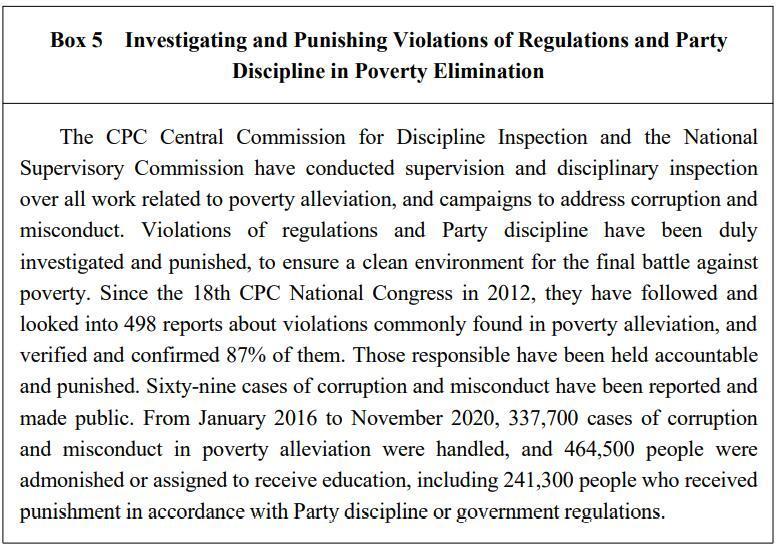
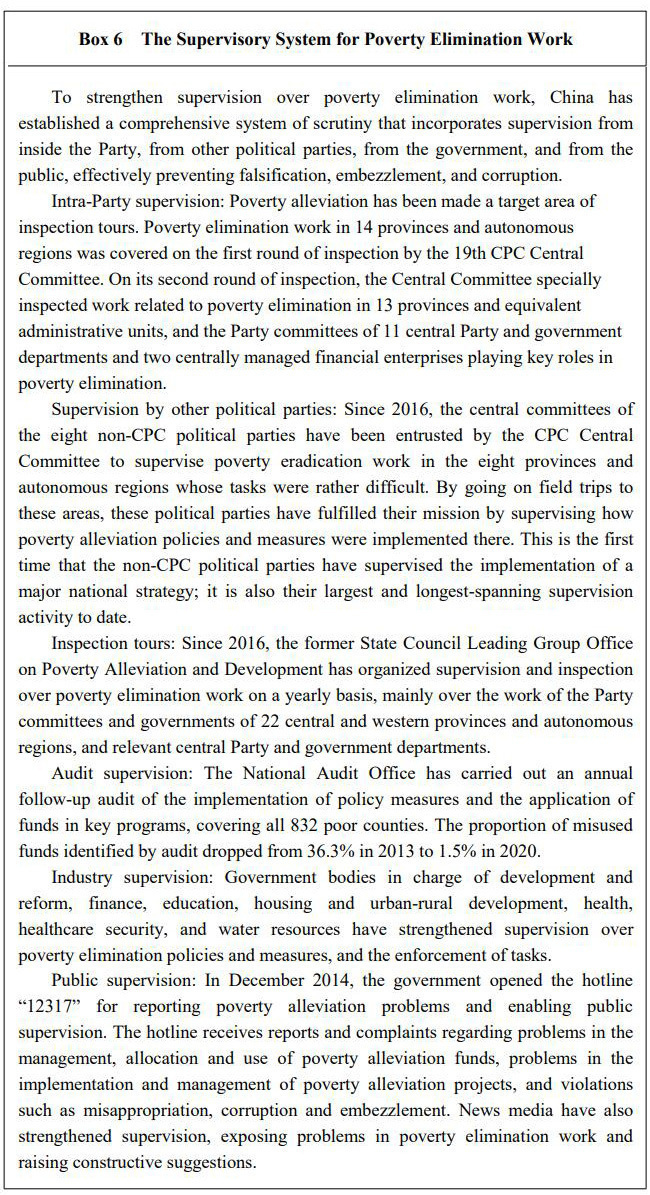
3. Applying Targeted Measures for Different Groups to Know How to Help
There are many different types of poverty and the causes vary from case to case. We cannot address the root cause without the right remedies. In practice, China has adopted categorized and targeted measures to reduce poverty, based on the situation of individual households, local conditions, and the causes for and types of poverty. These targeted measures include: boosting the economy to provide more job opportunities, relocating poor people from inhospitable areas, compensating for economic losses associated with reducing ecological damage, improving education in impoverished areas, and providing subsistence allowances for those unable to shake off poverty through their own efforts alone.
First, boosting the economy to provide more job opportunities. Poverty alleviation through economic development is the most direct and effective method, the fundamental way to give poor areas the capacity for independent development and help the poor find employment locally. With this in mind, China has supported and guided poor areas in developing economic activities geared to their available resources, and encouraged poverty alleviation through new forms of business and new industries such as e-commerce, photovoltaic (PV) power generation and tourism, and through the consumption of products and services from poor areas (Box 7). Relying on collaboration on poverty alleviation between the eastern and western regions, China has facilitated the transfer of food processing, clothes manufacturing, and other labor-intensive industries from the east to the west. With the growth of such specialty industries, poor areas have gained economic momentum. More than 300,000 industrial bases have been built, leading to the creation of new industries with distinctive features and greater capacity to facilitate poverty alleviation efforts. China has created 12,000 local agroproduct brands, 14,400 leading enterprises above the city level, and 719,000 rural cooperatives operated by farmers. A total of 72.6% of poor households have formed close ties with new types of agribusiness entities, and almost every poor household has been covered by policy support for boosting the economy. Almost all poor people with the ability and intention to work have joined the collective endeavor. Solid progress has been made in poverty alleviation through the development of science and technology. A total of 1,290 innovative platforms and business startups have been set up, and 77,000 people have been paired up with professionals to receive guidance on new technology in impoverished regions. With a team of 289,800 technicians and a fund of over RMB20 billion, China has launched 37,600 high-tech programs of all kinds and at all levels and introduced more than 50,000 advanced applied technologies and new, improved breeds. Poor households have received financial support such as small loans (Box 8). In poor villages, entrepreneurial individuals have been encouraged to start businesses and given support to help and lead others out of poverty.
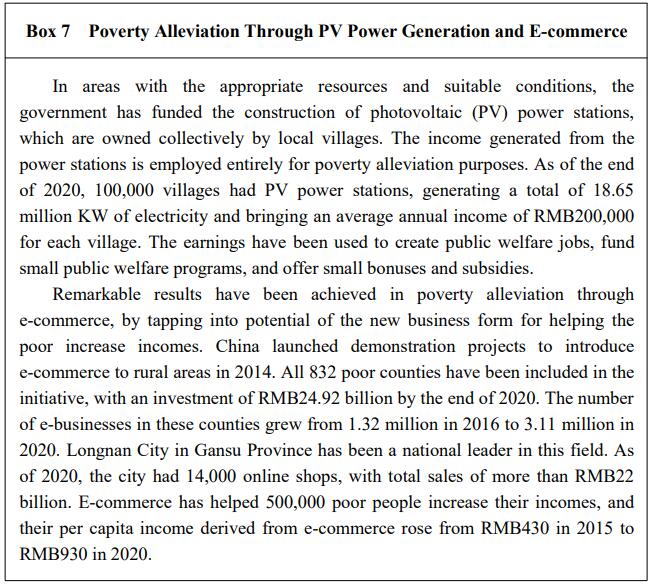
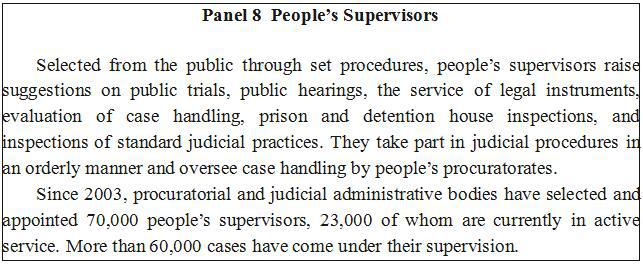
Second, relocating poor people from inhospitable areas. Some people lived in uninhabitable areas suffering from harsh natural conditions and subject to frequent natural disasters. It would be very hard for them to shake off poverty if they remained where they were, so the government relocated them to other areas (Box 9). The government respected these people's wishes, and only relocated those who were eligible and agreed to move. The reasons for relocation were explained to them but no coercion was used. The conditions and needs of target relocation groups were given full consideration, the scale of relocation was determined through research, and feasible plans were worked out and implemented in steps. As a result, more than 9.6 million people from inhospitable areas have shaken off poverty through relocation. Their former homes have been turned into farmland or planted with trees, to improve the eco-environment in these areas. In the resettlement sites, support facilities, industrial parks, and workshops have been built to create jobs for the relocated population, to ensure that they have stable incomes and equitable access to basic public services. Measures have been taken to ensure smooth relocation and resettlement, and make sure that those involved have the means to better themselves.
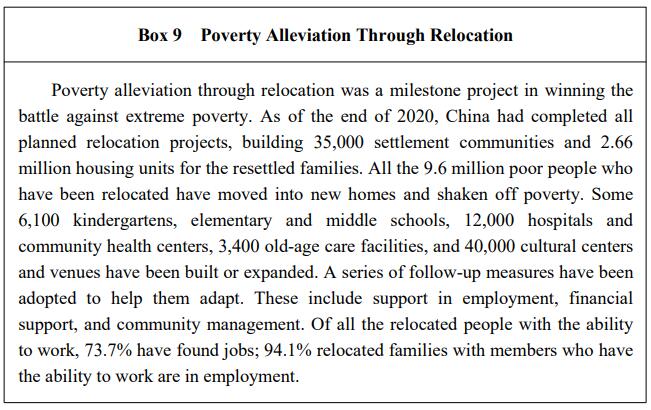
Third, shaking off poverty through compensations for economic losses associated with reducing ecological damage and getting eco-jobs. Clear waters and green mountains are invaluable assets. Laying equal emphasis on poverty alleviation and eco-conservation, China has strengthened ecological restoration and environmental protection in poor areas, increased government transfer payments to key eco-areas, and expanded the scope of those eligible for preferential policies. Poor people with the ability to work have thus been employed in eco-work, for example as forest rangers. Since 2013, a total of 4.97 million ha of farmland in poor areas has been returned to forest and grassland. A total of 1.1 million poor people have become forest rangers, and 23,000 poverty alleviation afforestation cooperatives/teams have been formed. By participating in projects for afforestation, turning reclaimed farmlands into forests or grasslands, restoring and protecting forests, grasslands and wetlands, and growing woody oil plants and working in forest tourism, the poor population have increased their incomes and made a major contribution to improving the eco-environment in poor areas, with mutually beneficial results.
Fourth, improving education in impoverished areas. Through education, poverty can be prevented from passing down from generation to generation (Box 10). The government has continued to increase support for schools in poor areas to improve their conditions, standard of teaching, faculties and financial resources. The state ensures compulsory education for all school-age children. All the 200,000 dropouts from compulsory education coming from poor families have returned to school. Favorable policies have been leveraged to enroll more poor students from designated areas, expand employment for graduates, and help students shake off poverty through vocational education. More than 8 million middle and high school graduates from poor families have received vocational training, 5.14 million poor students have received higher education, and key institutions of higher learning have admitted some 700,000 students from designated rural and poor areas. All this has opened up more channels for poor students to emerge from poverty and move upwards in society. The government has offered training on standard spoken and written Chinese language to 3.5 million rural teachers and young farmers and herdsmen in ethnic minority areas, in an effort to make poor people from these areas more competitive in the job market. A pilot campaign has been launched to teach standard Chinese to preschool children in Liangshan Yi Autonomous Prefecture, and Mabian Yi Autonomous County, Ebian Yi Autonomous County and Jinkouhe District in Leshan City, Sichuan Province, involving 430,000 children.
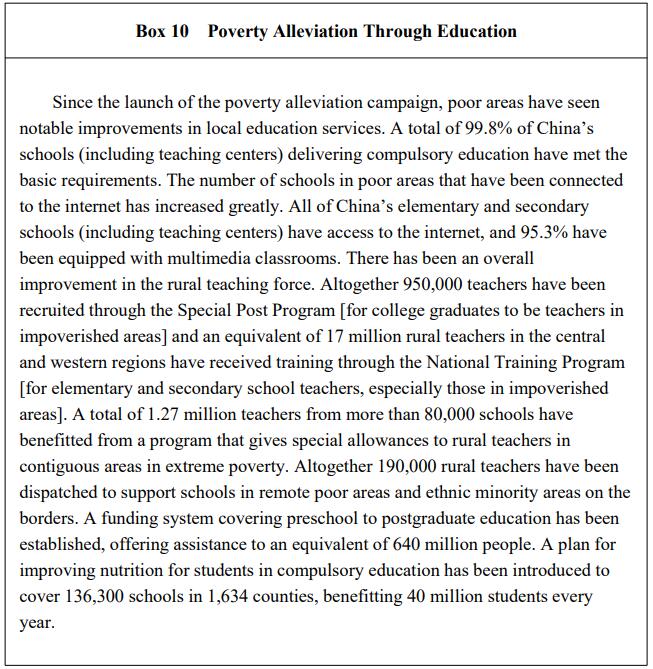
Fifth, providing subsistence allowances for those unable to shake off poverty through their own efforts alone. China focuses on the needs of the most vulnerable groups and provides them with subsistence allowances. Services and facilities to support people living in extreme poverty have been upgraded, with a greater capacity to provide care in service centers. The rural subsistence allowances framework has been effectively dovetailed with poverty alleviation policies, and the per capita yearly subsistence allowances in rural areas had grown from RMB2,068 in 2012 to RMB5,962 in 2020, an increase of 188.3%. The departments in charge of poverty alleviation and civil affairs compare data and verify information on a regular basis, to ensure full coverage of support for eligible groups.
China has also implemented many other forms of support for poverty alleviation that are consistent with local conditions. The government has redoubled its efforts to boost employment for the poor, through means such as offering free training on vocational skills, strengthening collaboration in the labor market between the eastern and western regions, supporting leading enterprises and workshops in poverty alleviation to create more jobs, encouraging entrepreneurial individuals to start businesses in their hometowns or villages, and creating public welfare jobs for the rest of the unemployed. Poor people who have the ability to work are encouraged to find employment locally or elsewhere, or start their own businesses. In 2015, 12.27 million poor laborers found employment; the figure had risen to 32.43 million in 2020. China has made efforts to improve healthcare service to the poor, considering it an important part of poverty alleviation in order to prevent the poor from sinking back into poverty due to illness (Box 11). China has launched a project to connect poor areas to the internet, introducing the "internet+" model for poverty alleviation in poor areas, especially in the extremely impoverished "three areas and three prefectures". The earnings from poverty alleviation funds and assets have been used to support the poor. The assets generated from facility agriculture – agriculture making extensive use of polytents and other similar equipment – PV power stations, and rural tourism using central government funds for poverty alleviation and other agriculture-related funds have been converted into shares and allocated proportionately to poor villages in order to give a boost to businesses, increase villagers' incomes and more importantly help solve the problem of generating revenue for the villages' collective economy. Since Covid-19 struck in 2020, China has adopted a series of support measures, such as measures to stabilize employment and encourage consumption of products from poor areas, effectively minimizing the impact of the virus.
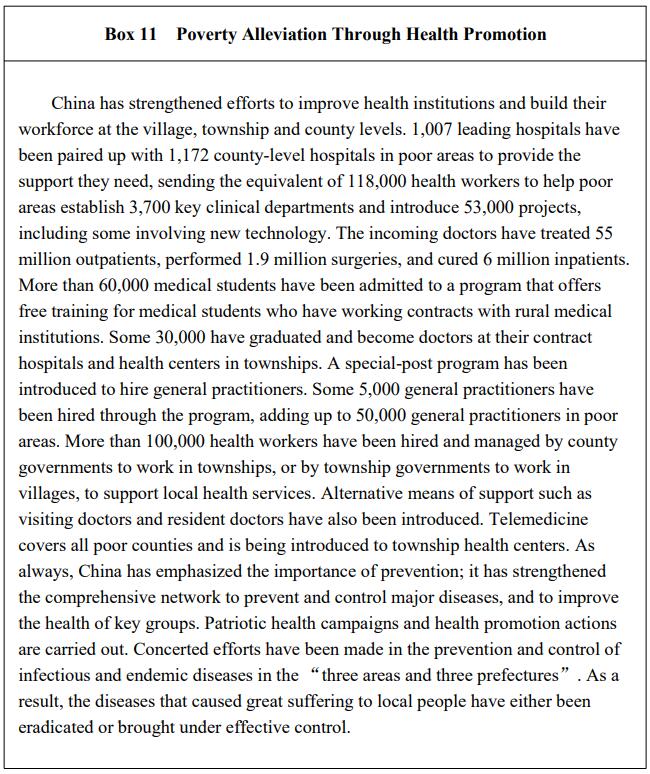
4. Adopting Strict Criteria to Know When and How to Deregister Those Who Have Emerged from Poverty
A poverty exit mechanism has been established, with clear provisions on the standards and procedures for deregistering from the list poor counties, villages, and individuals. This prevents misconduct such as manipulation and falsification of data, and also prevents those who have emerged from poverty from keeping the label in order to continue accessing preferential treatment. The government has worked out a poverty deregistration plan and an annual poverty alleviation plan to ensure procedure-based, rational and orderly exit from the registers. The criteria and procedures have been strictly enforced, for example, by conducting public review in the case of individuals and government examination in the case of villages and counties. The results of poverty exit have been disclosed for public evaluation and review, based on transparent procedures, accurate data and complete files, to ensure fairness. Supervision and inspection have been strengthened, including annual evaluations by third parties of the deregistered population and counties, with a focus on remote areas with weaker economic foundations. Three parameters – the accuracy of decisions, the poverty incidence of recurrence among deregistered counties, and public rating of assistance measures – are emphasized in evaluation, to ensure accurate results. From 2020 to early 2021, China conducted a general survey of poverty elimination, collecting accurate data on progress in helping the poor out of poverty. A "grace period" is allowed for previously impoverished population, villages and counties, during which time poverty alleviation policies and government supervision are continued until their status is secure.
5. Conducting Follow-up Monitoring to Help People Stay Out of Poverty
People and locations will only be considered to have shaken off poverty when they have stayed out of it and have not fallen back in after a certain period. Counties have been given a five-year period of grace from the day they emerged from poverty. During this period they will continue to enjoy the main support policies, which will be adjusted and optimized by category. Over time the resources leveraged for intensive poverty elimination will be redirected towards an extensive drive for rural revitalization. China will improve its dynamic monitoring of any trends indicating a return to poverty, and improve associated support measures. It will regularly check on key groups, such as those who have just emerged from poverty but whose position is far from secure, those on the verge of poverty who can fall back in again easily, and those experiencing difficulties in meeting their basic needs due to expenditure induced by illness, disaster or accident, or due to a sharp drop in income, and exercise dynamic management to spot these trends early and intervene through support measures, so that these people do not fall back into poverty. China will continue to support formerly impoverished areas in developing their specialty industries and help those who have emerged from poverty have stable employment. Follow-up support will be given to the resettled population whose employment will be promoted through multiple means. The government will improve social management to help them integrate into society, so that they will stay out of poverty, remain employed and have a promising future. Systems and practices that have proven effective, such as resident first secretaries and working teams, eastern-western collaboration, paired-up assistance, and social assistance, will be continued and improved. Efforts will be intensified to help those who have emerged from poverty build up self-belief and have access to education, so that they can create a better life through their own hard work. More evaluation will be carried out over the status of formerly impoverished people and areas, and Party committees and governments at all levels will continue to take responsibility to ensure that people do not sink back into poverty in large numbers.
The strategy of targeted poverty alleviation is China's strongest weapon in its final battle to secure victory against poverty, and a major innovation in the theory and practice of poverty alleviation. It highlights the CPC's sound approach whereby all actions are based on actual conditions and conform to the needs of development; it is a manifestation of its courage to face up to new challenges and find solutions through trial and error; of its tireless exploration of the characteristics of governance by the CPC, the development of socialism, and the evolution of human society; and of its pursuit of all-round development of the people and common prosperity for all. In addition to securing a sweeping victory in the final battle against poverty, the strategy has also given a powerful boost to modernizing China's national governance system and capacity, and to enriching and developing the CPC's guiding philosophies and governance strategies in the new era.
IV. Exploring a New Path of Poverty Alleviation
Eliminating poverty is a challenge for all countries. Each subject to different national conditions and at different stages of development, they adopt different poverty reduction criteria, methods and approaches. Bearing in mind its prevailing reality and understanding the nature of poverty and the status of poverty alleviation, China has embarked on a path of poverty alleviation and designed an approach with Chinese characteristics. In this battle, the nation has upheld the CPC leadership and the people-centered philosophy. It has taken advantage of one of the strengths of its socialist system – the ability to pool resources on major endeavors. It has adopted targeted measures and stimulated the enthusiasm, initiative, and creativity of the people in poverty. It has carried forward the great tradition of working together and offering mutual support, and it has adopted a down-to-earth and pragmatic style of work. In this approach, China has accumulated valuable experience, which belongs both to China itself and to the rest of the world, and offers enlightenment to the international community in its battle to reduce poverty.
1. People-centered Philosophy
The CPC is an ambitious party with a grand but simple goal: to ensure a happy life for the Chinese people. In the face of all the changes in the international landscape and the domestic situation over the past century, the Party has always followed a people-centered philosophy. It has borne in mind its founding mission to seek happiness for the Chinese people and national rejuvenation, and united and led the people in fighting poverty armed with firm convictions and a strong will. In the new era, the CPC has adopted a series of bold policies and measures to advance the cause, trying to ensure higher incomes and better education, healthcare, and living conditions for the poor. Taking public satisfaction as an important yardstick to judge the effectiveness of poverty elimination, the Party has concentrated its efforts on guaranteeing the basic needs of the poor. It would rather cut down on the number of major projects in favor of investment in poverty elimination; it would rather penalize short-term, partial or local interests to ensure the cause is well served and guaranteed; and it would rather slow the pace of economic growth to ensure the task of poverty alleviation is accomplished on schedule.
In the fight against poverty, officials including first Party secretaries and resident working teams, grassroots officials and Party members, and volunteers have worked with diligence and a spirit of dedication in support of the poor, fulfilling their mission and their pledge to the people. Some of them have been fighting on the front line for a long time, without time or energy to take care of their own families; some have been traveling around or braving harsh natural conditions; some have fallen sick from overwork all the year round; some have continued work even after getting injured at work. More than 1,800 Party members and officials have lost their lives in the cause of poverty alleviation.
China's poverty elimination effort in the new era is a full and vivid expression of its people-centered philosophy and the CPC's mission of serving the people wholeheartedly. Success in poverty alleviation has proven that the problem of poverty, in essence, is how the people should be treated: the people-centered philosophy is the fundamental driving force behind this cause. Only with this philosophy, can a country identify those who are poor, adopt concrete measures, and deliver genuine outcomes; only with this philosophy, can it draw on inexhaustible motivation, set a clear direction, and find the right approach.
2. Highlighting Poverty Alleviation in the Governance of China
Poor conditions for development in impoverished areas and a lack of capacity for self-improvement among the poor population determine that poverty cannot be eliminated by relying solely on the efforts of individuals, local governments, or non-governmental forces. Poverty elimination must be taken on as a responsibility of the ruling party and the country; it requires will and action at national level, and it must be elevated to a national strategy.
The CPC has always regarded poverty alleviation as an important task for ensuring national peace and stability. It has highlighted poverty alleviation at national level when setting its guidelines, principles and policies, and when formulating national plans for medium- and long-term development. The Party has pooled national resources to advance this cause and motivated generations of its members to devote themselves to this cause.
Since the 18th National Congress in 2012, the CPC has prioritized poverty elimination in its governance, and planned and advanced this cause under its centralized and unified leadership. All Party members, from top leaders to the grassroots officials, are concerned about the poor and the cause of poverty alleviation, and work together towards the same goal.
China has strengthened top-level design and strategic planning. It has issued policy documents such as Decision on Winning the Battle Against Extreme Poverty and Guidelines on the Three-Year Action Plan to Win the Battle Against Extreme Poverty, setting specific aims, defining approaches and detailed measures, and carrying them out with consistent efforts. Investment has been increased by governments at all levels (Figure 4) and a multiple investment system has been established (Box 12), guaranteeing financial support for poverty alleviation. Leveraging the strength of its socialist system – the ability to pool resources on major endeavors – China has mobilized forces from all quarters to participate in poverty alleviation. Systems have been established, covering responsibilities, policies, organization, inputs, mobilization, supervision, assessment and evaluation, and many other aspects of poverty elimination, providing an institutional guarantee for the nation to advance the battle against poverty.
The success in poverty alleviation has proven that governance of a country starts with the needs of the people, and that their prosperity is the responsibility of the government. Poverty alleviation is a pioneering and arduous trek. To achieve success, it is of utmost importance that the leadership have devotion, strong will and determination, and the ruling party and government assume their responsibilities to the people, play a leading role, mobilize forces from all quarters, and ensure policies are consistent and stable.
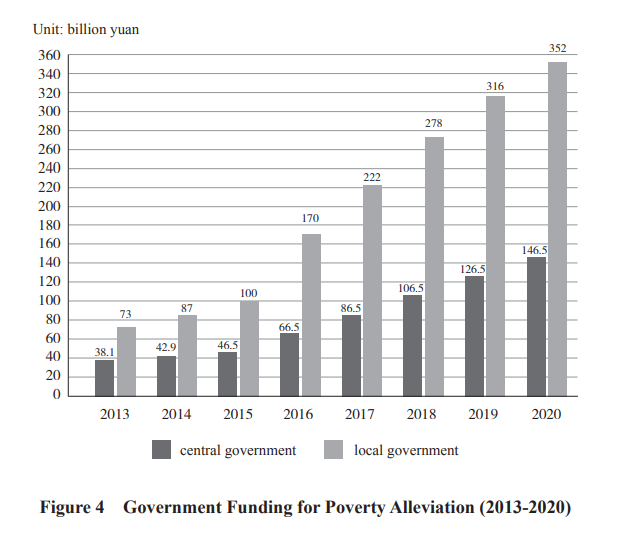
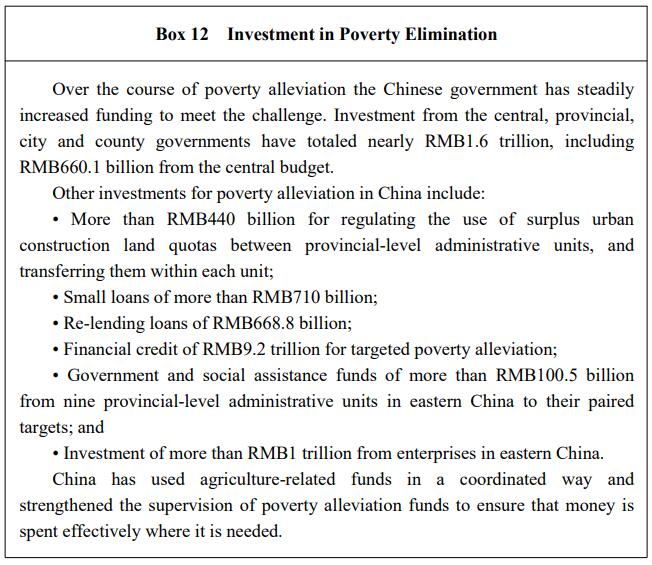
3. Eradicating Poverty Through Development
The root cause of poverty is inadequate development. As the world's largest developing country with a population of 1.4 billion, China is aware that development is essential to solving many of its problems, including poverty. The CPC has always regarded this as the top priority in governing and rejuvenating the country. It has concentrated its efforts in particular on the economy, to address the problem of unbalanced and inadequate development. Through development, the economy has been growing rapidly and the country has enjoyed a long period of social stability. China has regarded reform as an important driving force for poverty eradication and worked constantly to remove institutional and structural causes of poverty:
• By launching land reform and establishing the socialist system after the founding of the PRC in 1949;
• By implementing the household contract responsibility system with remuneration linked to output after the launch of reform and opening up in 1978;
• By establishing the socialist market economy and rescinding all agricultural taxes;
• By separating the ownership rights, contracting rights, and management rights for contracted rural land and further reforming the rural collective property rights system since the 18th CPC National Congress in 2012.
These measures have contributed to rural development and increased farmers' incomes. In addition, China has opened wider to the world amidst economic globalization and seen sustained and rapid growth in its foreign trade, creating many employment opportunities and more sources of higher incomes for rural labor.
Since the founding of the PRC in 1949, and especially since the launch of reform and opening up in 1978, the country has witnessed rapid economic and social development, with the economy and national strength growing steadily. This has provided solid support for large-scale development-driven poverty alleviation effort.
China's experience with poverty alleviation has proven that development is the most effective way to eradicate poverty and the most reliable path towards a more prosperous life. Only development can lead to economic growth, social progress and higher living standards. Only development can better guarantee people's basic rights and meet their desire for a better life.
4. Pressing Ahead with Poverty Alleviation Based on Reality
Poverty problems, as well as their causes, are diverse and complex. China's poverty alleviation efforts are based on a realistic appraisal of the situation. China has set its poverty line and its poverty alleviation goals and strategies, and worked to create better ideas and methods based on its national conditions and stage of development, and on the changes in the demographics, distribution, and structure of the poor population. It has advanced this undertaking step by step and with a steady effort.
Immediately after its founding in 1949, the PRC addressed the problem of poverty mainly through reform of the social system and large-scale economic development. After the launch of reform and opening up in 1978, China drove poverty alleviation mainly through rural economic reform and economic growth. It adopted development-oriented measures, guiding people in impoverished areas to increase their capacity for accumulation of wealth and endogenous development by adjusting the local economic structure, tapping into local resources, and developing production in response to market demand. In the new era, China has continued previous measures, and at the same time carried out a strategy of targeted poverty alleviation. The approach has changed from generalized broad-brush policies to targeted measures based on specific conditions. Before, resources for poverty alleviation came from multiple sources and were used by scattering them among the impoverished areas; now they are concentrated and better coordinated. The model of poverty alleviation has changed from mainly relying on external support like a blood transfusion to a more sustained effort from self-motivation. The assessment system has shifted focus from regional GDP as the main indicator to the genuine result of poverty alleviation. China has gradually lifted its poverty line based on its economic and social advances and progress in the cause of poverty alleviation to share the fruits of development with more people.
The occurrence and evolution of poverty has its own features and trends. To achieve success in reducing poverty, a country must follow a path in line with its national conditions, identify and remove obstacles to poverty alleviation, find driving forces for this cause, and constantly adjust and reform its strategies and policies as circumstances and local conditions change.
5. Letting the Poor Play the Principal Role
Poor people are the main players in eliminating poverty. Poverty alleviation requires both external and internal forces to form a synergy. China fully respects the principal role of the poor and encourages them to play their part, inspires them with the motivation to fight poverty, and enhances their ability to participate in development, share the fruits of development, and achieve endogenous development. They benefit from success in the undertaking of poverty alleviation and at the same time contribute to development in China.
China has inspired its people in poverty to strive for prosperity and provided them necessary education, so that they have the ambition to emerge from poverty and the tools to succeed. People in poverty have had better access to education opportunities, such as farmers' night schools and training workshops, to improve their skills and abilities in work and business.
A significant improvement in the battle against poverty is an effective mechanism of positive incentives encouraging the poor to learn from and keep pace with each other. Through this mechanism, productive activities are rewarded and subsidized and jobs instead of grants are provided, to encourage poor people to rely on their own efforts rather than wait for external assistance.
China has promoted stories of role models who escaped poverty through their hard work. It has also carried out various activities to establish the idea that "It is better to work hard than to endure poverty." The people in poverty have followed suit and eventually shaken off poverty and backwardness.
The fight against poverty shows that the people are the creators and drivers of history, and the true heroes. As long as a country serves the people, relies on them, respects their principal status and pioneering spirit, and motivates the poor to rely on their own hard work, it is sure to defeat poverty.
6. Pooling All Resources to Create Synergy
Poverty alleviation is an arduous, complex, and systematic endeavor, requiring the active participation of all parties. In the fight against poverty, the CPC has mobilized and pooled all possible forces on the basis of its rigorous organizational system and efficient work mechanism. A large-scale poverty alleviation network has been established, with the government, society and the market working in coordination, and government-sponsored projects, sector-specific programs, and corporate and societal assistance supplementing each other. It is a framework with the full participation of multiple players from different regions, sectors, departments and businesses.
China has strengthened collaboration and paired assistance between the eastern and western regions (Box 13) at provincial, city and county levels to encourage the flow of talent, capital, and technology to poor areas so that they can complement each other and narrow the gaps between them.
Poverty alleviation assistance has been directed to designated targets. Party and government institutions, people's organizations, state-owned enterprises and public institutions, and the military have assisted poor counties or villages (Box 14).
Other political parties, federations of industry and commerce and prominent individuals without party affiliation have leveraged their strengths to contribute intellectual and material support.
Various industries have been encouraged to offer assistance with their professional advantages by launching sector-specific programs, providing technological support, improving education, cultural undertakings and healthcare, and boosting consumption.
Private enterprises have been urged to participate in development-driven poverty alleviation. Businesses skilled in resource extraction have been encouraged to enter regions with great resource potential, which benefit both the businesses and those regions (Box 15).
Social organizations and individual citizens have been mobilized to participate in poverty alleviation and related public benefit activities. China has designated a National Poverty Alleviation Day and established a national system to commend models in fighting poverty. All these measures have created an atmosphere where everyone who is interested can join in poverty alleviation.
China's experience has proven that only when a country mobilizes all sectors of society to unite with common purpose and act in unison, can poverty be finally defeated.
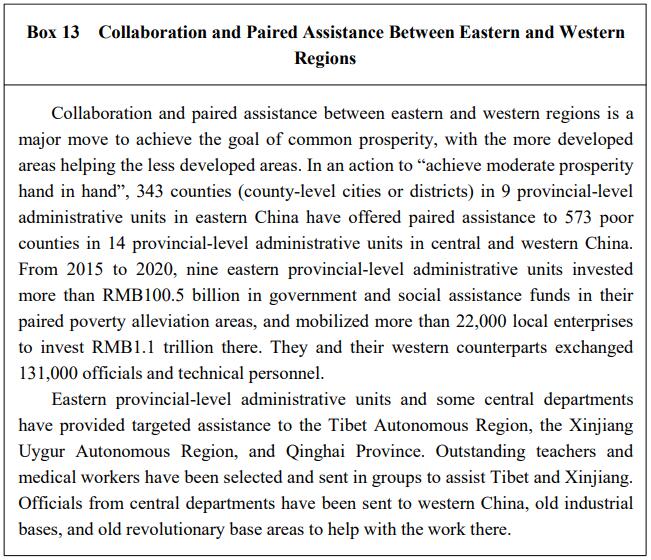
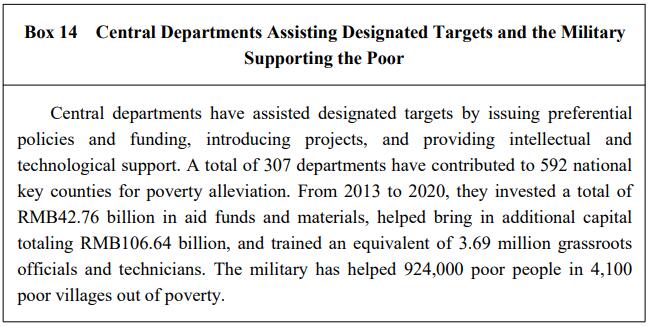
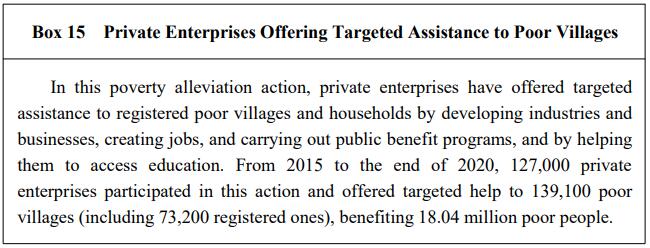
Under the CPC leadership, the Chinese people have created an approach to poverty alleviation with their own hard work. China's successful practice and valuable experience in eliminating extreme poverty have deepened human understanding of poverty alleviation trends, enriched and extended the theory of international poverty alleviation, and boosted the confidence of other countries, especially developing ones, in eradicating extreme poverty. They serve as reference for other countries to choose a suitable path of poverty alleviation, and offer China's approach to solving the problem of modern national governance and creating brighter prospects for social progress.
V. A Global Community of Shared Future Free from Poverty
China will prosper only when the world prospers, and vice versa. The country has always closely linked its future with that of the rest of the world. While committed to eradicating its own poverty, China has actively participated in international cooperation on poverty alleviation, acted as an advocate, facilitator of and contributor to the international cause of poverty alleviation, and worked with other countries to build a global community of shared future that is free from poverty and pursues common prosperity.
1. China as a Facilitator of the Global Cause of Poverty Alleviation
Over the past 100 years, China has contributed to global poverty alleviation under the leadership of the CPC through its own development – from winning the people's liberation to meeting their basic needs, from ensuring them a moderately prosperous life to building a moderately prosperous society in all respects. Since reform and opening up, more than 770 million of China's rural population living below the current poverty line have been raised from poverty, accounting for more than 70 percent of the global total over the same period according to the World Bank's international poverty standard. Against the backdrop of severe global poverty and a widening gap between the rich and the poor in some countries, China has won the battle against extreme poverty and achieved the poverty alleviation goal set on the UN 2030 Agenda for Sustainable Development 10 years ahead of schedule. This has significantly reduced the world's poor population and made a significant contribution towards realizing a better and more prosperous world, as envisioned by the Agenda[ UN Secretary-General Antonio Guterres extended congratulations to Chinese President Xi Jinping in February 2021 on the occasion of the announcement of China's success in the fight against extreme poverty. Noting this moment is a notable achievement and a significant contribution towards realizing a better and more prosperous world, as envisioned by the 2030 Agenda for Sustainable Development, the secretary-general said, "This extraordinary result is a reason for hope and inspiration to the entire community of nations."]. As the largest developing country, China has achieved rapid development in step with large-scale poverty alleviation, and economic transformation in step with the elimination of extreme poverty. It has completed all poverty eradication targets and tasks on schedule, which, as a new chapter in the history of the fight against poverty, has greatly accelerated global poverty alleviation.
2. International Support and Assistance
In the early years after the founding of the PRC, China made great efforts to break an external blockade and carry out international exchanges and cooperation in order to win the support of the international community. Since reform and opening up, China has conducted extensive cooperation with the UN development system and the World Bank in the field of poverty alleviation, while accepting assistance from some developed countries and carrying out cooperation projects. It has received support in financial input, knowledge transfer, and technical assistance, and learned from the advanced concepts and methods of the international community in poverty alleviation. All this has provided support to its poverty alleviation effort. In cooperation with the United Nations Development Program, the World Bank and other international organizations, China has implemented foreign-funded poverty alleviation projects in some poverty-stricken counties, bringing in various forms of concessional loan and grant aid. These international poverty-alleviation exchange and cooperation projects have alleviated poverty, improved China's institutional innovation and management, and laid a foundation for sustainable development in the project areas. The Chinese people will always remember the valuable support and assistance received from the international community. The Chinese nation never forgets the help and generosity it receives, and always reciprocates with the same goodwill; China has always supported other countries in poverty alleviation and development to the full extent of its ability.
3. International Exchanges and Cooperation
To improve the wellbeing of all peoples, China has taken an active part in global poverty management, furthered exchanges and cooperation with other countries, and promoted a new model of international exchanges and cooperation on poverty alleviation, with mutual respect and mutually-beneficial cooperation at its core.
China has supported other developing countries in poverty alleviation. Immediately after the founding of the PRC, China began to provide assistance to other developing countries in support of their struggle for national independence and liberation and for economic and social development, despite the fact that China had to address its own difficulties with limited financial resources. Since reform and opening up, China's foreign aid approach has diversified, which has promoted the common development of China and other developing countries. Entering the new era, China has fulfilled its responsibilities as a major country and upgraded its foreign aid into international development cooperation, contributing its vision and approaches to the resolution of global development challenges and the implementation of the UN 2030 Agenda for Sustainable Development. President Xi Jinping has announced on many major international occasions that China's practical measures for international development cooperation have been implemented on schedule or are progressing in an orderly manner (Box 16).
China has launched the Belt and Road Initiative (BRI) to expand deep and high-level regional cooperation on economic and social development, and to help eligible countries better achieve poverty alleviation. According to a World Bank study, the initiative will help 7.6 million people out of extreme poverty and 32 million out of moderate poverty in these countries. Over the past 70 years and more, China has provided assistance in various forms to over 160 countries in Asia, Africa, Latin America and the Caribbean, Oceania, and Europe, and international organizations, reduced or exempted the debts of eligible countries, and helped developing countries in their efforts to achieve the Millennium Development Goals.
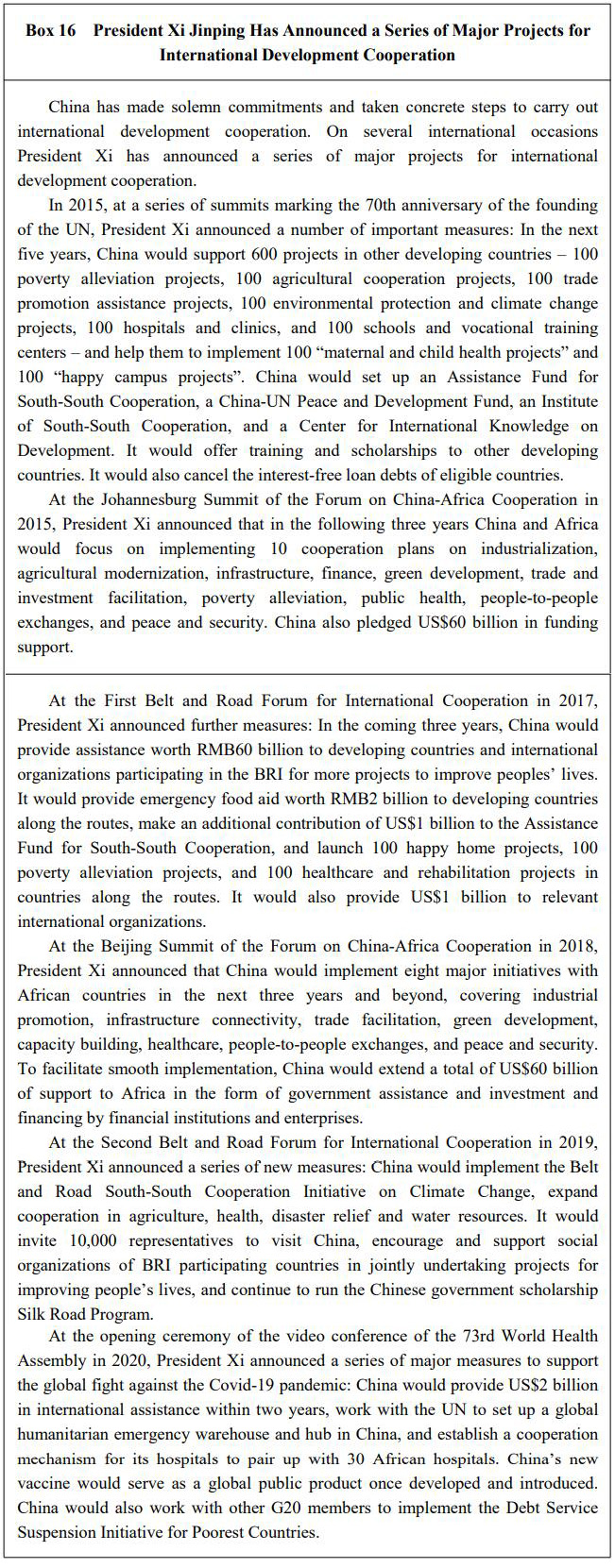
China has launched international poverty alleviation cooperation projects for the benefit of all. In Asia, China and ASEAN countries have jointly launched a rural poverty alleviation plan, and carried out the East Asia Poverty Reduction Demonstration Cooperation Technical Assistance Projects program in rural communities of Laos, Cambodia and Myanmar (Box 17). In Africa, China has helped African countries build water conservancy infrastructure, vocational and technical schools, government-subsidized housing, and other facilities, set up demonstration zones for agricultural cooperation, and carried out China-Africa cooperation projects involving a Chinese-invented technology using grass to grow mushrooms, China-Africa friendship hospitals, and the headquarters of the African Center for Disease Control and Prevention (Box 18). In the South Pacific region, China has promoted measures such as grant aid and concessional loans to Pacific island countries, and carried out technical cooperation assistance projects in infrastructure construction, agriculture, and medical care. In Latin America, China has built agricultural technology demonstration centers to help local people in recipient countries shake off poverty. China has also set up the International Research and Training Centre for Rural Education and other institutions in cooperation with UNESCO, and carried out projects on rural education transformation and teacher training for countries in Africa, Southeast Asia and other regions.
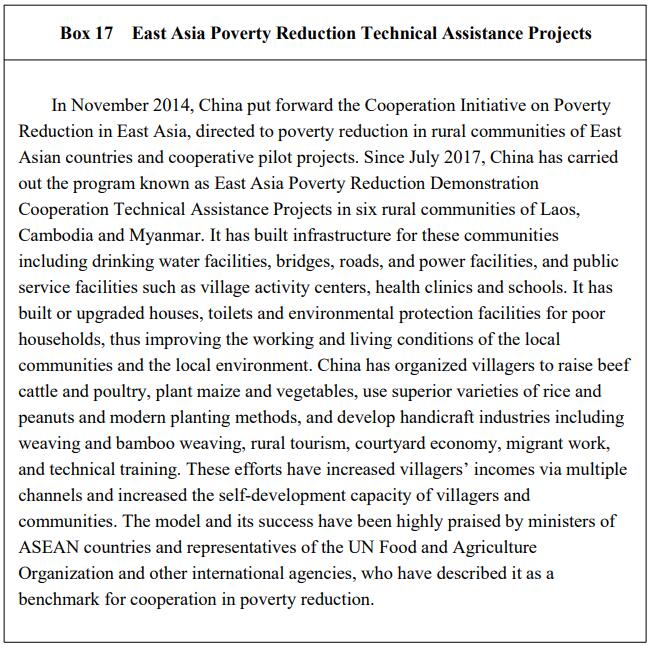
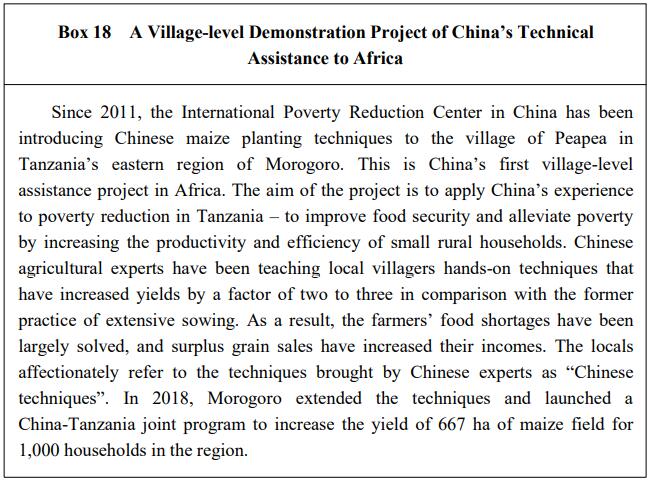
China has shared its experience on poverty reduction. It has carried out exchanges and cooperation in various forms, including building platforms, organizing training, and conducting think tank exchanges. Together with UN agencies in China, the Chinese government has convened sessions of the Global Poverty Reduction and Development Forum on the International Day for the Eradication of Poverty. China has initiated the China-ASEAN Forum on Social Development and Poverty Reduction, and the International Forum on Sharing Poverty Reduction Experience, and has hosted a series of discussion and exchange activities including the China-Africa Poverty Reduction and Development Conference, the International Seminar on Poverty Eradication and Responsibility of Political Parties, and the International Forum on Reform and Opening Up and Poverty Reduction in China. In cooperation with the ASEAN Secretariat and relevant ASEAN countries, China has launched the ASEAN Plus Three (China, Japan and the ROK) village official exchange program for grassroots village officials and community officials. China conducts international training on poverty reduction with relevant countries and regional organizations. Since 2012, it has held over 130 international training sessions, attended by officials from 116 countries and organizations.
The world today is experiencing a scale of change unseen in a century. The Covid-19 pandemic is still spreading around the world, and poverty, hunger and disease are undermining people's pursuit for a better life. The kind of world we should build and the future direction of human civilization, are issues that have a bearing on every country and every person. Everyone has the right to a decent life. All countries need to shoulder their responsibilities and work on poverty reduction, so that the sunshine of equity and justice can break through the haze of poverty and backwardness and illuminate a future of prosperity and development. China is ready to strengthen exchanges and cooperation with other countries on poverty reduction, support international poverty reduction, and make a greater contribution to building a global community of shared future that is free from poverty and blessed with common prosperity.
Conclusion
China has won the final battle against extreme poverty. By achieving the goals of the poverty elimination campaign as scheduled, the Chinese people have made solid strides towards a better life and common prosperity. Yet China remains the world's largest developing country, still confronted by the gap between unbalanced and inadequate development and the people's growing desire for a better life, and by the gaps between urban and rural areas and between regions. China still has much to do in order to realize people's all-round development and common prosperity for all.
Removing the label of extreme poverty is not the end, but the beginning of a new life and a new journey. The CPC will always remain committed to its founding mission, striving for the people's wellbeing and the rejuvenation of the Chinese nation. It will always put the people before everything else, and continue to work for people's all-round development, and common prosperity and a better life for all.
There will be no national rejuvenation without a thriving countryside. Following the victory in the final battle against extreme poverty, China will continue to consolidate the results of poverty elimination, dovetail new measures with rural revitalization, and shift its focus in work related to agriculture, rural areas and rural people. In the new era, China will act on its new development philosophy and build on its new development paradigm. It will prioritize affairs related to agriculture, rural areas and rural people, and follow a socialist path with Chinese characteristics in revitalizing the countryside by introducing more vigorous measures and pooling more resources.
By 2035, China will have achieved basic socialist modernization. With decisive progress in rural revitalization by that time, agriculture and rural areas will be modernized and fundamentally restructured. Farmers will benefit from the quality employment which comes with better jobs, relative poverty will be further alleviated, and concrete progress will be made in achieving common prosperity for all. Rural areas will enjoy the same basic public services as urban areas, brought about by improved systems and mechanisms for urban-rural integration. Farmers will enjoy a better cultural environment in civil and neighborly communities, and benefit from improved rural governance. There will be a fundamental improvement in the eco-environment; the goal of building a beautiful, livable countryside will be basically realized.
By 2050, China will have become a great modern socialist country in every dimension, realizing the Second Centenary Goal and fully revitalizing the countryside. At that time, China will have a strong agriculture, a beautiful and revitalized countryside, and prosperous farmers, enjoying across-the-board progress in society and the economy, and thriving endeavors in every sector. At that time, the Chinese people will embrace a happier life in common prosperity, and the nation will continue to march towards higher goals of all-round development of the people and common prosperity for all.
China cannot develop in isolation from the rest of the world; and the world needs China for further development. With this in mind, China has always been a builder of global peace, a contributor to global growth, and a guardian of the international order. In the future, a more prosperous China will also be more open and inclusive; it will interact more constructively with the international community, and make a greater contribution to building a better world.
Appendix
Adjustments of China's Poverty Standards
China has implemented large-scale planned and organized poverty alleviation programs. Standards for poverty alleviation were formulated according to its social and economic development and the basic living needs of its poor populations.
In 1986, China set its first poverty standard at RMB206, designed to provide adequate food and clothing for 125 million poor. In 2001, when formulating the Outline of Development-driven Poverty Alleviation in Rural Areas (2001-2010), the nation raised the standard to RMB865 for 94.23 million poor. In 2011, when formulating the Outline of Development-driven Poverty Alleviation in Rural Areas (2011-2020), China readjusted the standard to RMB2,300 (based on the 2010 price index) to help 122 million poor.
In the final stage of fighting extreme poverty, impoverished people in China were registered and deregistered by household. The criteria are personal incomes, and the household's situation with reference to the Two Assurances and Three Guarantees. The former requires that the annual average per capita income for a household remains steady above China's current poverty line. The latter refers to guarantees of adequate food and clothing, and access to compulsory education, basic medical services, and safe housing for impoverished rural residents.
China's standards for deregistering those who have emerged from poverty are comprehensive, including income, and the extent to which they are assured the rights to subsistence and development. These standards reflect the realities of China's social and economic development as well as the basic requirements for achieving moderate prosperity in all respects.